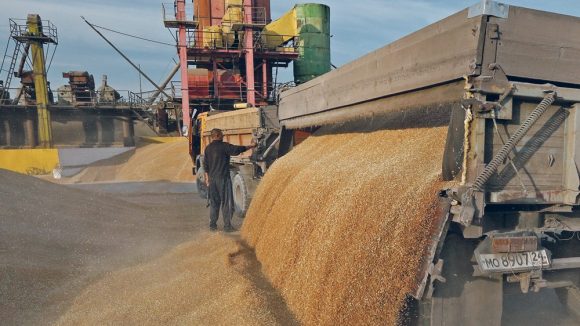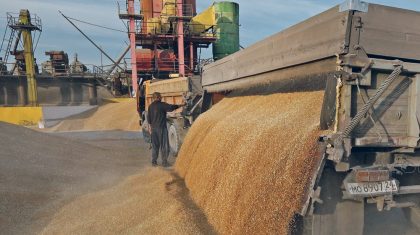
Russian Farmers did not reach the record. Grain harvest rose, but prices did not fall !!!
At the beginning of 2019, almost all experts in the grain market predicted that the gross grain yield would again be close to a record and amount to about 130 million tons. Due to the influence of weather factors, expectations did not materialize. But production will still be high again: about 8-10 million tons less than the initial estimates and as much more than a year earlier. But grain export, despite the growth in volumes, is still inactive. High domestic prices and reduced stocks no longer provide for export.
Before the start of harvesting, the Russian crop-2019 was estimated by experts from 125 to 135 million tons of grain, which could raise it to the record or second after the 2017 record, when 135.5 million tons were received. In mid-October, the harvesting campaign for wheat and barley was almost completed, corn crops were threshed only half. However, it was already clear that the wheat crop would be 4.5-5 million tons more than a year earlier, barley – 3.5-4 million tons, an increase of several million tons was also expected for corn. But the total harvest was seen by experts as more than 120 million tons, which nevertheless could be the second result in terms of production in the entire history of the country.
Just a very good Crop !!
For grain producers and according to their own assessment, this year for the industry can be called the average among the last five years, said the president of the National Union of Grain Producers(NHA) Pavel Skurikhin. The factors that corrected the production results were the deterioration and partial death of winter crops in winter and early spring, the lag in the optimal timing of sowing work (not everything was possible to fulfill from the originally planned plans), as well as arid phenomena in several regions of the country. At the same time, the threshed crop in the current agricultural year fully meets the country’s needs and export potential, he emphasizes. According to a preliminary assessment of the NHA, the gross grain harvest will be 117-118 million tons in bunker weight, of which about 78 million will be produced by wheat.
The forecast of the union is perhaps the lowest in the market. Analytical Center ” SovEkon“In September estimated grain production at 118.2 million tons, wheat – at 74.9 million tons. Head of the analytical center” Rusagrotransa“Igor Pavensky expects the crop to total 120.5 million tons.” In fact, this is the level of 2016, when a smaller harvest of wheat (73.3 million tons) was offset by a large production of corn – 15.6 million tons (in 2019 13.2 million tons are forecasted) and other grains (rye, millet, etc.), the expert comments. “This year we will get about 75.4 million tons of wheat.” The crop will be good, despite the drought that has affected a number of regions of both the Central European part and the east of the country, he draws attention.
Evaluation of the analytical company ProZerno”- 121.4 million tons, including 75 million tons of wheat. The average cereal yield on October 16 was 26.9 c / ha against 25.5 c / ha in 2018. According to the results of 2019, this indicator will remain higher, according to ProZerna CEO Vladimir Petrichenko. “Of particular note is that yields will be higher than in 2016,” he says.
Russian Grain Union( RZS) speaks of 121.7 million tons of grain and 74.9 million tons of wheat. “The main positive dynamics is associated with barley,” explains Elena Tyurina, director of the analytical department of the RZS . “His harvest per hectare on October 16 was 12.5% higher than on the same date last year.” At the same time, barley was threshed on this date with 96.2% of the area.
Forecast of the Institute for Agricultural Market Studies ( IKAR) – 112 million tons, including 75.4 million tons of wheat, 20.4 million tons of barley, 13.8 million tons of corn. “These figures have not undergone significant changes since the end of August,” says Dmitry Rylko, general director of the company. Among the main features of the 2019/20 season, he calls drought in the south at the very end of the growing season. Then, the harvest was hot and dry for three weeks before harvesting, which, on the one hand, helped wheat gain protein (its indicators are very high), and on the other hand, transferred forecasts from the “super-high” crop category to just “very good”.
The fact that the quality of wheat has improved is confirmed by Aleksey Orlov, general director of the Orenburg-based Elany. “The drought did not pass by the Volga Federal District, which resulted in yields slightly lower than expected – 14-15 kg / ha for wheat and 18 kg / ha for rye, but with a higher protein,” he says. “Due to the fact that we made good money on cereals last season, this year we were able to triple the fertilizer application area, which also had a positive effect.”
Weather has made adjustments to the work of the agricultural holding “Grain of Life” (part of Samara ” SINKO“): The rains complicated the vegetation and harvesting season, but overall, thanks to the calm beginning of October, the work was successful, the representative of the SINKO group’s sales division shares-Trade »Norayr Mnatsakanyan. “A feature of the season for the Samara region was a low fall number – a lot of wheat, in all respects corresponding to the third class, was assigned to the fifth only because this indicator was below 80 (mills usually buy grain with a fall number of 250), – he reports. “But it was precisely at our agricultural holding that feed grain amounted to only 10%.”
Disappointed with the productivity of wheat, the General Director of Siberian Bread (Novosibirsk Region) Pavel Miklukhin. Instead of the planned 25 kg / ha, the company received 10-15 kg / ha due to the lack of rain. But “shot” rye – 35 kg / ha, which the manager calls a “surprisingly good” indicator.
Outlook 2020
In early October, sowing winter cereals in the southern regions was lagging behind last year due to lack of rainfall, says Igor Pavensky from Rusagrotrans. However, by mid-October, the backlog had decreased from 1.3 million ha to 0.6 million ha, and there was still enough time to reach the performance of 2018. In other regions, the sowing campaign was held at the same pace and with approximately the same area as a year earlier. “Given the rather favorable situation, especially in the South, where the bulk of winter grains are produced (about 60%), it is likely that they will generally occupy as much as in the previous year – about 18 million hectares,” the expert believes . “Then everything will depend on weather conditions in winter and spring.”
Sowing winter crops in the Volga region can already be called a record, adds Dmitry Rylko from IKAR. And the condition of the crops there is also very good, he notes. In general, the area under the grain for the 2020 crop is likely to remain at about the same level as in 2019, he agrees with Pavensky. Unless they grow up slightly under wheat – by about 150-200 thousand hectares, the expert said.
Prices have not fallen
In general, the season for agricultural producers, like the past, is developing favorably. Although the situation on the foreign market is not as interesting as it was a year earlier, Pavensky draws attention: export prices are significantly lower than in 2018/19. So, wheat with a protein of 12.5% cost in mid-October $ 196 / t against $ 228 / t a year ago. At the same time, since the beginning of the agricultural year, when prices formed at the level of $ 192 / t, they have grown very slightly, moreover, by September there was a significant drop – to $ 184-185 / t (all prices are FOB Black Sea).
At the same time, in the domestic market, almost from the start of the season, after a short-term decline in July, grain increased in price everywhere. The growth from the beginning – mid-July to October in the South and in the Center amounted to 12-14% due to the significant until recently demand from domestic processors and relatively high export rates compared to average values in recent years. “The reasons for the current situation of imbalance between domestic and export prices in the midst of the season are also associated with a decrease in wheat stocks compared to last year,” Pavensky explains. “In almost all regions except the central ones, including in the South, they were on October 1 at a five-year low.”
Almost a third of grain grown in Russia is export-oriented, recalls Skurikhin. Therefore, the situation on the world market directly affects in-country pricing. In anticipation of the 2019/20 season, the average price of wheat with 12.5% protein was about $ 205 / t (FOB Black Sea). As a result, a good pricing environment developed in the Russian market. At the beginning of the season in the European part of the country, average prices for wheat of the third class started at 11.5 thousand rubles / t, the fourth – 10.6 thousand rubles / t, and the fifth – 9.6 thousand rubles / t. “By October, these levels, of course, fell, but they still provided agricultural producers with acceptable profitability,” the expert said. So, according to the NHA, in the Central Federal District, wheat of the third class on average cost 10.95 thousand rubles / t, fourth – 10.3 thousand rubles / t, and fodder – 9.25 thousand rubles / t.
A significant external factor affecting the grain market is the fall in world wheat prices due to the high harvest in the world, says Dmitry Rylko. “Of course, this will negatively affect the profitability of agricultural producers,” he is pessimistic. – If at the beginning of October 2018 wheat was traded at $ 225 / t (14.94 thousand rubles / t at the current exchange rate of the ruble), then in the same month of 2019 – $ 191 / t (12.4 thousand rubles. / t). Total difference of 2.5 thousand rubles. – a significant gap. ” The situation is not critical, but it is possible that because of this the growth in fertilizer consumption for the next season and investment in agricultural technologies will be inhibited, the expert fears.
In addition, by September, with a good harvest, prices for wheat and barley in the domestic market usually line up at or below export parity, Rylko adds. However, this year, prices throughout almost the entire territory of European Russia and Siberia continue to remain much higher than the level required for active export. He explains the situation for two reasons. Firstly, after record high prices for all grains in the 2018/19 season, livestock breeders decided to form stocks at the beginning of the season, which led to an acceleration of prices. “Secondly, now we have the largest state player in our market (VTB), which is engaged in procurement, regardless of market prices,” the expert says.
In October, Yelan sold a batch of durum wheat with a protein of 14% at a price of 14 thousand rubles per ton. But prices for soft wheat in the Orenburg region as a whole correspond to the levels of the previous year – 10-10.5 thousand rubles per ton with VAT. Therefore, while the sales company has suspended and will continue selling after the New Year.
In the Novosibirsk Region, wheat prices are kept at 8.5-11 thousand rubles per ton, depending on the class, says Miklukhin. “The impact of export prices on the domestic market is obvious, but this fall they were even higher than the base, not because of grain shortages, but because of informational stuffing regarding the situation on the global market and fears of processors,” he said. Rye was pleased with good prices: this year it costs almost as much as wheat – 8-9 thousand rubles / ton without VAT. The manager explains this by the fact that in the current season exporters became interested in rye, and many farmers, on the contrary, did not pay due attention to it – they reduced the area.
According to Mnatsakanyan, the cost of wheat with gluten 24-25% in the Volga Federal District is at the level of 10.5 thousand rubles per ton with VAT. “We have our own flour mills, our high-quality wheat goes there, but we have to buy it on the side, and prices are similar to export prices,” he draws attention. “Of course, in such a situation, we are not talking about active grain supplies abroad, exporters sell mainly stocks that were previously made.”
Grain stocks
As of September 1, agricultural, procurement and processing organizations amounted to 42.8 million tons, which is 6.5% less than on the same date in 2018, Rosstat informed. Wheat residues at the same time were estimated at 30.5 million tons – 10.3% lower than last year.
Sluggish Export
Despite the fact that a second crop is expected after the 2017 record, Russian prices at the start of the season did not fall, as is traditionally the case. At the beginning of the agricultural year, this led to the fact that the competitiveness of Russian wheat was at a low level, emphasizes the president of the RZSArkady Zlochevsky. As a result, amid low export prices, shipments abroad are still “sluggish”, but the situation will change in the second half of the season, as domestic wheat prices will decline, he said. “Shipments abroad will remain inactive until winter, but insufficient export rates will lead to stockpiling and critical pressure on the market,” the expert predicts. “From the second half of the season, competitiveness will probably level off due to a fall in domestic prices, as a result of which export will increase.” According to the results of the season 2019/20, RZS predicts the export of grain at the level of 47 million tons.
The imbalance in the domestic and foreign markets should level out by the end of 2019, agrees with Zlochevsky Pavensky. Exporters will try to increase prices for the world market, based on rising costs for the purchase of wheat domestically. “Russia is still a leader in the global wheat market,” the expert recalls. “The level of $ 200 / t is already visible.” He also draws attention to the fact that, despite the high season, tariffs for infrastructure services (railway transportation, transshipment) decreased by 20-30% compared to last year in order to stimulate export deliveries amid the prevailing pricing environment of the domestic and world markets. “The fall in transshipment rates due to high competition among exporters and rising domestic prices can be called a rarity,” says the director of the analytical center “SovEcon»Andrey Sizov. “Usually, if this happens, then not at the beginning of the season.” According to him, prices for “deep water” fell from $ 20-25 / t to $ 15-17 / t, and this is not the limit, he thinks.
According to Rusagrotrans», In July – September about 13.8 million tons of grain were shipped abroad, which is 10% less than for the same period in 2018/19. The lag in wheat is about 8%: 12 million tons were delivered abroad in three months. Nevertheless, on average about 4.6 million tons of grain were shipped on a monthly basis, and the maximum volume was unconventionally exported in July – 4.7 million tons. In August and 4.5 million tons were exported in September, reports Pavensky. “And this is significantly higher than the pace of previous years, with the exception of 2018, when there were sufficiently large carry-over stocks after the record crop of 2017 and much higher export prices,” he notes. According to the forecast of Rusagrotrans», In total in the 2019/20 season, the export of grain and legumes (including export to the EAEU countries) may reach about 43.5 million tons against 45.1 million tons in 2018/19, including wheat – 34.4 million tons (36 million tons a year earlier).
Vladimir Petrichenko estimates the potential volume that Russia can supply abroad this season at 45.7 million tons against 44 million tons in 2018/19. Of these, 35 million tons will be in wheat. “That is, according to the latter, there will be practically a repeat of last year’s result with an increase in the export of barley and corn,” he explains. According to the forecast of the NHA, up to 40 million tons of grain can be sent abroad. Assessment ” SovEkona“- 41.9 million tons of grain crops, including 31.9 million tons of wheat.
At the same time, the projected world final stocks in the 2019/20 season remain at a record level due to good gross wheat harvests in all major exporting countries, continues to Pavensky. “Further support for this may come from lower estimates of export potential in Australia and Argentina, which are expected to enter the world market in the near future,” he says. “There are problems harvesting spring wheat and corn in the United States.” In addition, a slowdown in exports, primarily due to trans-shipment, and cooling activity in the domestic market already leads to price stabilization at least in the Center and in the Volga region, the expert knows. At the same time, Siberia is still cut off from external deliveries through southern ports due to rising prices due to extremely significant demand from Kazakhstan, where due to drought, wheat production is projected to drop to 11–11.5 million tons against 13.4 million tons a year earlier. “Significant volumes are already leaving for Kazakhstan mainly by road from the Siberian, Ural and even Volga regions,” says Pavensky. “Thus, up to 1 million tons of grain can be delivered there, compared to 700-800 thousand tons in previous seasons.”
For exporters themselves, agricultural years turned out to be quite difficult because of the gap between domestic and foreign prices. “Naturally, in such a situation, the volume of exported grain falls, the marginality decreases,” acknowledges Alexander Grigoryants, Commercial Director of Globex Agro (grain exporter). “Our export structure has also changed: a smaller volume goes to the southern ports and the Baltic states, a larger one – to Azerbaijan and the domestic market.” But overall, sales have plummeted since August. According to the top manager, so far there is no reason for a substantial increase in export prices, but a decrease in domestic prices could be expected. But now producers are holding high-quality wheat, hoping for the best market conditions, and selling oil seeds, beets and other agricultural crops. All this does not help stabilize the situation and maintains disparity in prices.
Director General of Zerno-Trade (one of the top 5 largest grain exporters for the 2018/19 season) Alexey Yushush believes that difficult conditions for exporters were due to the fact that market participants overestimated the harvest – the forecast was much more optimistic, than the real result. “And now there are too many ambitious players on the market who need to fulfill the previously given supply obligations. The competition has intensified more than ever, exporters themselves are raising prices and can’t get out of this vicious circle, ”says the top manager. The dollar exchange rate, which fell to 63 rubles / $ 1, also played into the hands of business. “So forecasts are a thankless task. Trusting them, you can seriously miscalculate – and this is how it happened this season, ”complains Edush.
Stock farmers stock up
According to the forecast of ProZerna, domestic grain consumption in the 2019/20 season will decrease by almost 1 million tons to 78.4 million tons. Wheat, whose consumption will decrease by 3 million tons to 42.4 million tons with an increase in barley consumption, will determine this trend. by 1.5 million tons to 14.9 million tons and corn – by 0.5 million tons to 9.1 million tons. According to Vladimir Petrichenko, the decrease will occur due to a decrease in demand from the livestock industry. “If earlier consumption in animal husbandry was either stable or grew a little, then in this agricultural year it will decrease, although not very significantly,” he said. “So, the number of birds last season fell below the rate of 2017, and now it is even smaller.”
There is a trend towards a gradual decrease in grain consumption and for food purposes, adds Zlochevsky. In particular, due to a slight decrease in demand for bakery products. “Usually, a drop in household incomes, on the contrary, causes an increase in demand for bread, but this year we see a decrease in it. The paradigm for healthy consumption is having its effect, ”said the expert.
Pavensky still expects some growth in domestic grain consumption due to livestock breeders. However, this segment has already faced a decrease in livestock dynamics compared to previous years in poultry farming with continued growth in pig farming, as well as a deterioration in the pricing environment for final products in the domestic market, he adds.
Breeders themselves are hoping for lower grain prices this season. In mid-October, feed wheat cost about 10.5 thousand rubles per ton, then estimated the chief analyst of Cherkizov, Andrei Dalnov. At the same time, there was a shortage of feed wheat in the market with an excess of fourth-grade food. As a result, prices for these categories have almost leveled off, although overall price levels have so far been about 5-7% lower than a year ago. “Breeders can hope that the average price in the 2019/20 season will be generally lower than in the past agricultural year,” he comments. “But, according to USDA forecasts, with a good harvest (72.5 million tons), wheat stocks at the end of the season may become the lowest in recent years and amount to 7.7 million tons, which is a risk factor for consumers.” Evaluation of the final residues of the OWSeven lower – only 6 million tons, which will be the lowest level over the past five years. By the end of the previous agricultural year, stocks were estimated at 10 million tons. Cherkizovo itself»Has grain reserves for three to four months. Full use of storage capacity would increase this period to six months, says Dalnov.
The cost of feed has already increased, says the general director of the poultry factory “Sinyavinskaya”(Leningrad region) Arthur Koldoenko. “In July, grain prices rose by 10-15% compared to the same period last year, although due to the increased harvest and global market conditions, we expected the opposite trend,” he draws attention. Now the company is sending all available and saved money to purchase grain and other raw materials. At the same time, in the Urals and Siberia, where the weather was not very good during harvesting, wheat may be of lower quality than the company needs, a top manager fears.
In October, grain prices were lower than in the beginning or mid-2019, the head of the National Meat Association notes( Intangible) Sergey Yushin. And livestock farmers have adapted to the current price, he said. But with further rise in price of grain, many not the most advanced enterprises in the industry will experience difficulties. “This, of course, will affect those who are in the investment phase,” he warns. But nevertheless, intensified competition, especially noticeable in the pig breeding sector, will affect the profitability of livestock breeders this year. “Due to the lack of access of our producers to major export markets such as China, South Korea and Japan, the rapidly growing supply of domestic pork puts significant pressure on wholesale prices and, therefore, on the profitability of enterprises,” concludes Yushin.
Grain quality is very high.
Julia Koroleva, Director, Grain Quality Assessment Center
This year marks a very high quality grain. For the first time in seven years, first-class wheat has been identified. The share of wheat of the third class is almost a third of the total crop volume. Whole wheat of the first or fourth grade (formerly GOST – food wheat) – 80% of the total harvest. The grain quality was affected by dry, hot weather, as a result of which the protein in wheat grew record-high. This allows exporters to form batches with this indicator from 13.5-14.5% and higher. This fact changed the direction of export, for example, shipments to Turkey doubled compared to the same period last year. At the beginning of October, the country’s share in Russian grain export was 22%.
Also this year we, fortunately, do not face the problem of sprouted grain, whose share in 2018 reached 15% in some regions. Then the problem of “seedling” significantly limited Russian exporters in choosing the countries of destination for their supplies.








